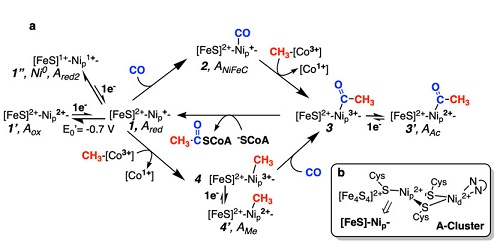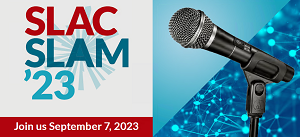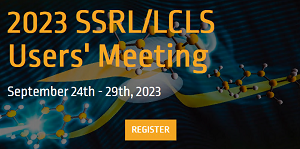
SSRL Operations Restart
We are preparing to restart user operations following the electrical incident and transformer failure earlier this year. We hope to be able to restart SPEAR3 and resume user operations later this month or in early August. We plan to continue the FY2023 run year through September 5. After a brief shut down for infrastructure, maintenance and upgrade work, we plan to resume user operations for the FY2024 run year in November and continue through July 2024. Stay tuned and visit our website for the latest information.
SSRL Science Highlight
Visualizing the Mechanism of an Ancient Pathway in the Carbon Cycle – Contacts: Stephen Ragsdale (University of Michigan) and Ritimukta Sarangi (SSRL)

In the early days when life was just beginning to dawn on planet earth, the first organisms were faced with a task that all life on earth still faces today: How can I generate energy and grow? This life, like us had a voracious need for carbon, and utilizing the metals available to it in those ancient oceans, developed several methods for growth that pulled CO2 from its surroundings. One such primordial method is the Wood-Ljungdahl pathway (WLP).
This ancient process was and is facilitated by an elegant arrangement of four proteins in a multiunit complex that includes two enzymes with nickel- and iron-based active sites: carbon monoxide dehydrogenase (CODH) and acetyl-CoA synthase (ACS). With the help of several other auxiliary enzymes, CODH and ACS transform CO2 into acetate through a complex series of nickel-based intermediates. How exactly acetate is formed in this manner has been the subject of debate for decades. Read more...
More SSRL Science & News
New SLAC-Stanford Battery Center Targets Roadblocks to a Sustainable Energy Transition
Excerpt from SLAC News Article by Glennda Chui
SLAC National Accelerator Laboratory and Stanford University have launched of a new joint battery center at SLAC. It will bring together the resources and expertise of the national lab, the university and Silicon Valley to accelerate the deployment of batteries and other energy storage solutions as part of the energy transition that’s essential for addressing climate change.
A key part of this transition will be to decarbonize the world’s transportation systems and electric grids – to power them without fossil fuels. To do so, society will need to develop the capacity to store several hundred terawatt-hours of sustainably generated energy. Only about 1% of that capacity is in place today.
Filling the enormous gap between what we have and what we need is one of the biggest challenges in energy research and development. It will require that experts in chemistry, materials science, engineering and a host of other fields join forces to make batteries safer, more efficient and less costly and manufacture them more sustainably from earth-abundant materials, all on a global scale. Read more...
See also Stanford Daily Article about the launch.
On the Road Toward Cleaner Batteries
Excerpt from SLAC News Q&A by David Krause
Over the past decade, SSRL scientist Johanna Nelson Weker has watched hundreds of batteries charge, discharge, and ultimately fizzle out. Her team’s research has improved the understanding of battery reliability. More reliable batteries are needed to power more things than ever, including electric grid storage facilities, cars, trucks and even leaf blowers.
But the story of battery proliferation can’t remain focused on performance first, Nelson Weker says. The industry has arrived at its next big fork in the road: how to build batteries using abundant and ethically mined materials. The most popular type of batteries today, lithium ion, requires materials that can be hard to source – and some of which have documented human rights concerns associated with mining practices outside of the United States.
Nelson Weker’s team at SSRL is currently focused on finding ways to design batteries that use alternative materials, like zinc and manganese, rather than lithium and cobalt. Read more...
Humidity – Not Just Light – Causes Color Degradation in Historical Paintings, Researchers Discover
Excerpt from SLAC News Article by David Krause
The research team from SSRL, the University of Amsterdam, Rijksmuseum and other institutions wanted to explain why a form, or species, of arsenic called As(V) is found alongside a yellow arsenic sulfide pigment called orpiment. Previous research has shown that the conversion of the pigments to As(V) can cause color degradation, but the roots of this change have remained unclear.

To study the As(V) species, the research team took a small sample out of the 17th century painting, “Still Life with Flowers in a Glass Vase,” by Jan Davidszoon de Heem. The yellow eglantine rose at the center of the painting has been fading to white.
To see the color change in the yellow rose in greater detail, the researchers zapped the sample with bright x-rays generated at SSRL’s beam line 2-3. These x-rays provided researchers with 2D images of the sample’s cross section and the locations of the arsenic species. After snapping x-ray images, the researchers placed the paint sample under an x-ray microscope on beam line 6-2C to image the chemistry of the arsenic species in higher resolution and 3D. Combing these x-ray techniques allowed the team to map the degradation pathways. These pathways revealed that exposure to humidity creates a trail for the arsenic species to travel on. Read more...
Citation: T. H. Broers, Webb, Nelson Weker, et al., Journal of The American Chemical Society 14 April 2023 (doi/10.1021/jacs.2c12271)
Events
SLAC SLAM on September 7, 2023

The SLAC SLAM is a competition in which contestants give a 3-minute presentation on their research at a non-scientist level to a live audience. Judging will be based on the scientific content and the entertainment of your presentation. SLAC Postdocs, research associates, and new staff members at SLAC are eligible to compete, and others are encouraged to attend to cheer on the participants and learn more about research at SLAC . The winners will advance to a Bay Area SLAM against the other local national labs on October 5, and the congressionally sponsored National Research SLAM in Washington on November 15. If you will be at SLAC on September 7 and are interested in participating in the SLAC SLAM competition, please contact Ariana Gleason, Carmen Lau or Michael Peskin.
SSRL/LCLS Users' Meeting, SLAC, September 24–29, 2023, Menlo Park, CA
Our Annual Users' Meeting is a unique opportunity to gather together the light source community in a scientific event that includes numerous workshops, plenary presentations and poster sessions. An in-person event is planned for September 24–29 this year. Participants can learn about current/future facility capabilities and the latest user research and discuss science with colleagues from academia, research laboratories, and industry worldwide
The plenary sessions on September 27–28 will feature updates from the DOE and our facility directors and talks by invited speakers and award recipients. Our poster session and reception will be held on Wednesday, September 27, as will an LCLS-II First Light Symposium. Additionally, workshops will be held throughout the week.
Visit the Users' Meeting website to register and learn more about the planned activities.
Announcements
Call for SSRL Award Nominations
Encourage your colleagues to reflect on accomplishments over the past year and submit award nominations by the posted deadlines. Recipients of the Spicer and Klein awards will be asked to present their research during the plenary session of the joint SSRL/LCLS Users’ Meeting, which will be held on September 24–29, 2023. Send nomination packages to Cathy Knotts.
Melvin P. Klein Scientific Development Award – Submit Nominations by August 1: This $1,000 award honoring Mel Klein's many contributions recognizes research accomplishments of undergraduate/graduate students or postdoctoral fellows within three years of receiving their Ph.D. This award provides peer recognition and helps to promote dissemination of results based on work performed at SSRL. The nomination package should include the candidate’s CV, letters of recommendation from the advisor and colleagues, as well as an abstract written by the candidate describing the SSRL-related experiments, scientific results, and plans to present the findings.
Farrel W. Lytle Award – Submit Nominations by August 5: The $1,000 Lytle Award was established to promote technical or scientific accomplishments in synchrotron radiation-based science and to foster collaboration and efficient use of beam time at SSRL. SSRL users and staff are eligible to be nominated for the Lytle Award. Letters of nominations should include a summary of the individual's contributions and why they should be recognized through this award. Supporting letters are welcome.
Call for Abstracts for the SSRL/LCLS Users' Meeting Fundamentals Workshop
Are you a student, postdoc, or research assistant who has conducted measurements at SSRL, LCLS, UED and/or cryoEM? The SSRL/LCLS User’s Meeting has introduced a new symposium where early career scientists can highlight their research making use of particular SLAC user facility capabilities in a 15-minute oral presentation. The symposium will take place Monday, September 25. Expert PhD scientists will give talks introducing techniques available at SSRL, LCLS, UED and the cryoEM facilities followed by examples of early career research. The symposium will cover x-ray crystallography/diffraction, spectroscopy, imaging and electron methods (cryoEM/UED). Early career work which spans multiple techniques or user facilities at SLAC are especially encouraged. Abstracts from all technical fields are welcome. Please consider taking part in this new symposium and sharing your work with other users while learning about work being conducted and what the vast capabilities at SLAC user facilities have to offer. Awards for best oral presentation will be presented at the end of the session. Please submit abstracts through this link by July 28 for consideration and register for the Users’ Meeting.
If you have questions regarding the symposium or abstract submission, please contact the workshop organizers at fundamentals.ssrl.lcls@gmail.com
Call for Nominations for the SSRL Users’ Executive Committee by September 1
We welcome candidates interested in standing for election to the SSRL Users Executive Committee (UEC). The SSRL UEC provides an organized framework for interaction between the SSRL scientific user community and SSRL Management. We are currently seeking nominations from the Biospectroscopy/BIO SAXS, Environmental/Geosciences, and Macromolecular Crystallography communities as well as graduate students in any discipline. The SSRL UEC meets periodically throughout the year to plan the Users' Meeting in coordination with the LCLS UEC, select recipients for several awards, provide input to SSRL management on topics of interest to the user community, and to raise awareness about SSRL capabilities, user science and accomplishments to a broader audience. UEC elections are held annually in conjunction with our Users' Meeting which will be held next September 24–29, 2023. Nomination form
Postdoctoral Opportunities at SSRL
SSRL scientists are looking for postdoctoral candidates for the positions listed at Careers at SLAC.
The Nature of X-Rays and Their Interactions with Matter
A new book by Joachim Stohr, former director of SSRL and LCLS, The Nature of X-Rays and Their Interactions with Matter, gives a comprehensive account of modern x-ray science, based on the use of synchrotron radiation and x-ray-free electron lasers (XFELs). Learn more
User Research Administration
Beam Time Requests
- Xray / VUV - August 1, 2023 (November 2023 – January 2024 cycle)
- Macromolecular Crystallography - September 7, 2023 (November 2023 – February 2024 cycle)
Proposal Deadlines
- Xray / VUV - August 1, 2023 (for beam time eligibility beginning in February 2024)
- Macromolecular Crystallography - December 1, 2023 (for beam time eligibility beginning in March 2024)
- CryoEM biology-related proposals for the S2C2 program are due on the first day of each month and are being reviewed on a monthly basis.
- July 21, 2023 is the next application deadline for cryoET sample preparation at the Stanford-SLAC CryoET Specimen Preparation Center (SCSC). Application is through a unified process for the four centers comprising the National Network for Cryo-Electron Tomography. The application can be found at https://www.cryoetportal.org/.
Submit SSRL and CryoEM S2C2 time requests and proposals through the User Portal.
The Stanford Synchrotron Radiation Lightsource (SSRL) is a third-generation light source producing extremely bright x-rays for basic and applied research. SSRL attracts and supports scientists from around the world who use its state-of-the-art capabilities to make discoveries that benefit society. SSRL, a U.S. DOE Office of Science national user facility, is a Directorate of SLAC National Accelerator Laboratory, operated by Stanford University for the U.S. Department of Energy Office of Science. The SSRL Structural Molecular Biology Program is supported by the DOE Office of Biological and Environmental Research, and by the National Institutes of Health, National Institute of General Medical Sciences. For more information about SSRL science, operations and schedules, visit http://www-ssrl.slac.stanford.edu.
To unsubscribe from SSRL Headlines, just send an e-mail to listserv@slac.stanford.edu with "signoff ssrl-headlines" in the body.
To subscribe, send an e-mail to with "subscribe ssrl-headlines" in the body.
Questions? Comments? Contact Lisa Dunn





